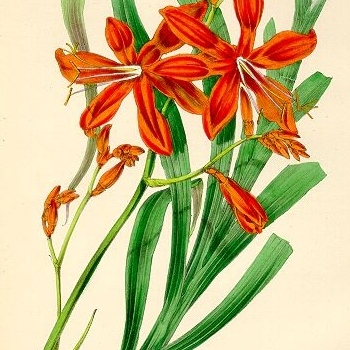Plants mostly 500-800 mm high. Corm globose, persistent in series under main corm, ± 25 mm diam., with cormlets at base and on short rhizome-like stolons; tunics brown, fibrous, soon disintegrating. Stem suberect or inclined to drooping, sometimes with 1 or 2 short branches. Leaves several in a basal fan, ± lanceolate, tapering to narrow, petiole-like base, pleated, usually shorter than stem, 25-50 mm wide. Spike flexed at base and ± horizontal, with numerous flowers borne on upper side facing spike apex; bracts soft-textured, green, becoming dry from tips, outer 5-10 mm long, inner shorter than outer, forked apically. Flowers zygomorphic, bright orange (rarely yellow), unscented; perianth tube obliquely funnel-shaped, curving upward, 18-25 mm long, lower 1/2 narrow and cylindric, widening above to 10 mm at mouth; tepals spreading when fully open, dorsal largest, 20-30 mm long, suberect, others 18-26 mm long, curving outward, outer 5-7 mm wide, inner 7-12 mm wide. Filaments 30-35 mm long; anthers 7-9 mm long, reaching apex of dorsal tepal. Style exserted from tube, 42-45 mm long, dividing opposite anther tips, branches ± 3.5 mm long, bilobed to forked at tips. Capsules depressed-globose, 3-lobed, ± 10 x 9 mm. Seeds ± 4 mm diam., ovoid-angular, lightly wrinkled, dark brown, 2 or 3 per locule.
More
Perennial herb, geophyte, 0.5-0.8 m high; corm globose, tunics brown, fibrous, in superposed rows; stem suberect, branched. Leaves ± lanceolate-acuminate, plicate, up to 600 x 20-50 mm, base stalk-like. Bracts green, becoming dry on apex; outer apiculate; inner bifid and shorter than outer. Inflorescence a horizontally curved spike, usually simple, may have ascending branches; flowers orange-scarlet, zygomorphic, facing apex, secund on upper side; tube funnel-shaped, curving upwards; lower part smaller and cylindrical; lobes slightly unequal, spreading, dorsal larger, suberect. Stamens exserted, unilateral. Style exserted, often overtopping anthers; stigma slightly widened or shortly bifid, fimbriate. Flowering time Dec., Jan. Capsule depressed-globose; 3-lobed.

